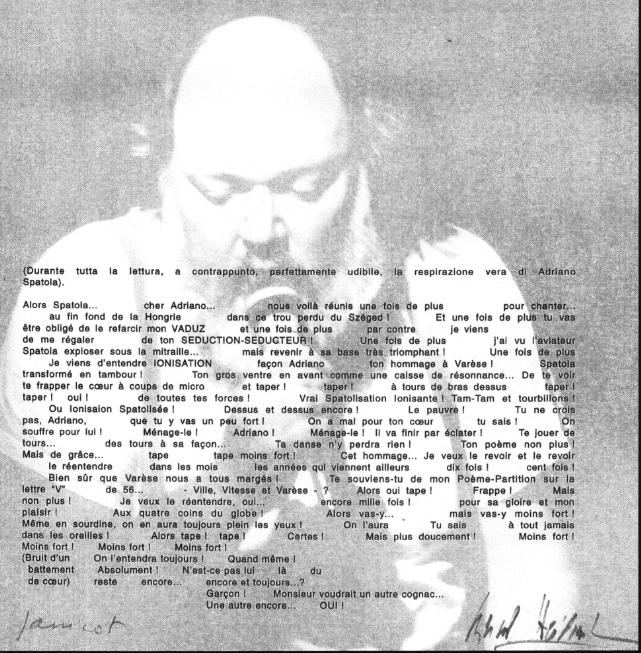|
In 1968 Spatola, with his brothers, Maurizio and Tiziano, founded “Edizioni Geiger”, entirely devoted
to the publishing of poetic and artistic experimental texts.Within their scope he published, with Giulia Niccolai,
the literary magazine “Tam-Tam” which, from 1971, was, till his death, the crucible of many young authors.
He created the magazine of sound poetry, on cassettes , “Baobab, phonetic information - il dolce stil suono” .
The theory of Total Poetry, which Spatola elaborated, is rooted in the distant past and is akin to that of
the fusion of arts, with various solutions, from Wagner’s total spectacle to the Greek tragic theatre, from
the melodic and dancing declamation of Indian epos to the Japanese Kabuki theatre, to the Balinese theatre and so on.
But in actual fact Total Poetry, as intended by Spatola, is based on the idea of interlanguage as an art practice
into which there flow together various components - poetry, painting, music, mimicry - whose borders become flimsier
and flimsier and therefore can be more easily superimposed. For example, traditional linear poetry tends to become,
on the one hand visual, approaching plastic arts and on the other hand ‘sound’, thus trespassing on
the specific territory of music. And it is not a matter of phenomena of “confusion”, but on the contrary of new forms
of expression. Thus the theatre merges into sculpture, poetry becomes action, music gesture and in its notation,
painting. Terms and practices such as “event”, “happening”, “environment”, “mixed media”, “assemblage”, “performance”
are born.
In his “Il quaderno bianco”, the opening section of “Diversi Accorgimenti” (Several Devices) Spatola suggests in verse
the new situation in which the artist acts:
A sound which corresponds to the weft of distance
to the remote request of accomplice machination
to the algebraic canon to the clash of new fragments
an accomplishment of substance in the order of contrivance
and again:
The position in which the mind has been caught
becomes fantasy, the projection of a world.
As far as Spatola’s own linear poetry is concerned, Aldo Tagliaferri writes “Intorno a un’idea di totalità”
(About an idea of total poetry) in “Homage to Spatola”, “il Verri”, n.4 dec. 1991: “it is important to note
that the associations round which Spatola’s exuberant love of metaphors plays... imply a conception
of the unconscious much more pliant and self-conscious that the one which underlines the ingenuous automatism
of surrealism. Half-way between the external indeterminate and the internal determinate, balanced Narcissus
and Oedipus masterfully intertwined in the texts collected under the title “La composizione del testo”
(the Composition of the Text) (“a verb is the parasite the narcissus, the rage under the skin”)
Spatola’s poetry has not illusions about allowing the unconscious to speak directly, nor does it
make mention of the essence of paradox, which was once the prerogative of historic vanguards, more often
than it removes it. By the side of “total poetry”, which explicitly aims (visually) to create “a still
not exhausted series of metamorphoses of the poetry “genre” and obtains its specific results, there stands
therefore the poetry which, entrusted to the bare word and not to the intermedia programming, upsets
the expectations and the codes of the reader, elaborating the “privilege” of a style. By the approach,
less striking than the one which is ideologically aimed at the search for totality, Spatola has succeeded
in renovating a tradition by reinventing it.
As far as visual-concrete poetry is concerned, Spatola belongs not so much to the classic concretism of Gomringer
and of the Noigandres Group as to the variant opened by Franz Mon with his “Testi Superficie” (“Surface Texts”)
where, taking the printed page of a book, a newspaper, and illustrated magazine and so on, the text is dissected
into fragments which are then put together in a collage on a next page. In this way are born also
Spatola’s “Zeroglifici” (Zeroglyphics): the word is destroyed, only a graphic shambles remains of it.
In a sense the zeroglyphic, that is the reduction to grade zero of the verbal meaning, visually corresponds
to the sound research on phonemes, inaugurated by Lora-Totino in 1964 at the Studio di Informazione Estetica
di Torino ( Turin Studio of Aesthetic Information ) And it is not irrelevant that in a manuscript later published
in “Homage to Spatola”, Spatola revealed that “ in most cases my visual texts are also scores, sometimes
in a direct way, sometime in an allusive way. The allusion is mostly to the serial aidea of a preordained
succession of sounds, or rather to the phantom of this idea. If a certain number of variants if established
for the eye, the spectrum or mirror of seriality becomes an inevitable consequence.”
His works:
“Le pietre e gli dei”, Tamari, Bologna 1961
“L’Oblò”, Feltrinelli, Milano 1964
“Poesia da montare”, Sanpietro, Bologna 1965
“L’ebreo negro”, Scheiwiller, Milano 1966
“Zeroglifico”, Sampietro, Bologna 1966
“Verso la poesia totale”, Rumma, Salerno 1969 ; Paravia, Torino 1978.
“Majakovskiiiiiiij” , Geiger, Torino 1971
“Diversi accorgimenti”, Geiger, Torino 1975
“Algoritmo”, Geiger, Torino 1976
“Various Devices”, by Paul Vangelisti, Los Angeles 1977
“La composizione del testo”, Cooperativa Scrittori, Roma 1978
“La piegatura del foglio”, Guida, Napoli 1983
“La definizione del prezzo”, “Tam Tam”, Martello, Modena/Milano 1990
|
